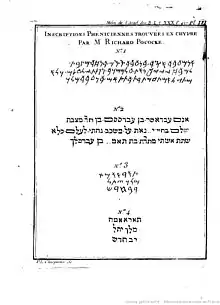Pococke Kition inscriptions
The Pococke Kition inscriptions were a group of 31 Phoenician and 2 non-Phoenician inscriptions found in Cyprus and published by Richard Pococke in 1745. In describing Kition (modern Larnaca), Pococke wrote: "the walls seem to have been very strong, and in the foundations there have been found many stones, with inscriptions on them, in an unintelligible character, which I suppose, is the antient [sic] Phoenician..."[1]
| Pococke Kition inscriptions | |
|---|---|
 The inscriptions | |
| Writing | Phoenician |
| Discovered | 1738 |
| Present location | mostly destroyed |
The Phoenician inscriptions are known as KAI 33 (CIS I 11), KAI 35 (CIS I 46) and CIS I 57-85. They represent some of the most important finds in Phoenician and Semitic language studies, as they were used by Jean-Jacques Barthélemy in his decipherment of the Phoenician language.
Only one of the inscriptions still survives, in the Ashmolean Museum - all the rest were destroyed in construction work in 1749.[2][3]
Surviving inscription – KAI 35
The sole surviving inscription is a marble funeral stone, numbered "2" in Pococke's sketch, measuring 12 x 3 x 3 inches; the inscription is in memory of a deceased wife. The inscription was brought to England by a Dr. Porter of Thaxted, and presented to Oxford University by Charles Gray MP in 1751.[4][5] It was published many times, first by Pococke, and then by John Swinton, Richard Chandler, Jean-Jacques Barthélemy, Wilhelm Gesenius,[5] and Johan David Åkerblad.[2]
Today it resides at the Ashmolean Museum.
Concordance
| Pococke | 1 | 2 | 3 | 4 | 5 | 6 | 7 | 8 | 9 | 10 | 11 | 12 | 13 | 14 | 15 | 16 | 17 | 18 | 19 | 20 | 21 | 22 | 23 | 24 | 25 | 26 | 27 | 28 | 29 | 30 | 31 | 32 | 33 |
|---|---|---|---|---|---|---|---|---|---|---|---|---|---|---|---|---|---|---|---|---|---|---|---|---|---|---|---|---|---|---|---|---|---|
| CIS | 11 | 46 | 57 | 64 | 73 | 82 | 74 | 60 | NP | 81 | 79 | 68 | 80 | 78 | 67 | 76 | 70 | 66 | NP | 59 | 71 | 62 | 58 | 65 | 77 | 69 | 83 | 85 | 61 | 72 | 75 | 84 | 63 |
| CIS | 11 | 46 | 57 | 58 | 59 | 60 | 61 | 62 | 63 | 64 | 65 | 66 | 67 | 68 | 69 | 70 | 71 | 72 | 73 | 74 | 75 | 76 | 77 | 78 | 79 | 80 | 81 | 82 | 83 | 84 | 85 | NP | NP |
| Pococke | 1 | 2 | 3 | 23 | 20 | 8 | 29 | 22 | 33 | 4 | 24 | 18 | 15 | 12 | 26 | 17 | 21 | 30 | 5 | 7 | 31 | 16 | 25 | 14 | 11 | 13 | 10 | 6 | 27 | 32 | 28 | 9 | 19 |
Gallery
 A page from Barthélemy's publication of his decipherment of Phoenician: "Inscriptions Phéniciennes, trouvées en Chypre par M Richard Pococke". No. 1 is Pococke's No. 2 (KAI 35), and No. 3 is Pococke's No. 4. The other two are Hebrew transliterations of the same inscriptions.
A page from Barthélemy's publication of his decipherment of Phoenician: "Inscriptions Phéniciennes, trouvées en Chypre par M Richard Pococke". No. 1 is Pococke's No. 2 (KAI 35), and No. 3 is Pococke's No. 4. The other two are Hebrew transliterations of the same inscriptions. Concordance with the Corpus Inscriptionum Semiticarum (see table at bottom)
Concordance with the Corpus Inscriptionum Semiticarum (see table at bottom).jpg.webp) The only surviving inscription, today at the Ashmolean Museum
The only surviving inscription, today at the Ashmolean Museum
Notes
- Pococke, v. II pg. 213
- Fredrik Thomasson (11 January 2013). The Life of J. D. Åkerblad: Egyptian Decipherment and Orientalism in Revolutionary Times. BRILL. pp. 93–. ISBN 978-90-04-23635-6.
- CIS I, p.39, "Lapides interea ad aquaeductus molem struendam adhibuit vir turca insulae Cypro praefectus Beschir, circa annum 1749; ut monumenta ipsa reperiendi spes omnis linquenda sit, nisi aquaeductus ipse destruatur."
- https://collections.ashmolean.org/collection/browse-9148/per_page/25/offset/39025/sort_by/size/object/70553
- Macray, William Dunn (1868). Annals of the Bodleian Library, Oxford, A. D. 1598-A. D. 1867: With a Preliminary Notice of the Earlier Library Founded in the Fourteenth Century. Rivingtons. p. 162.
Charles Gray, M.P. for Colchester, presented… an inscription, in the Phoenician language, upon a white marble stone, which was brought, with many others, from Citium, in the island of Cyprus, by Dr. Porter, a physician of Thaxted in Essex. The stone measures twelve inches in length, by three in breadth, and three in depth. It has been frequently engraved: first by Pocock (Travels in the East, vol. ii. pl.xxxiii. 2); next by Swinton (Inscriptiones Citieae, 1750, and Philos. Trans. 1764); afterwards by Chandler, Barthélemy, &c; and, lastly, by Gesenius (for whom former copies were collated with the original, and corrected, by Mr. Reay) in his Scripturae Linguæque Phaenicia, Monumenta, published in 1837, where the inscription is described at pp. 126-133, part i., and engraved at pl. xi. part iii. It appears to be an epitaph by a husband in memory of his wife.